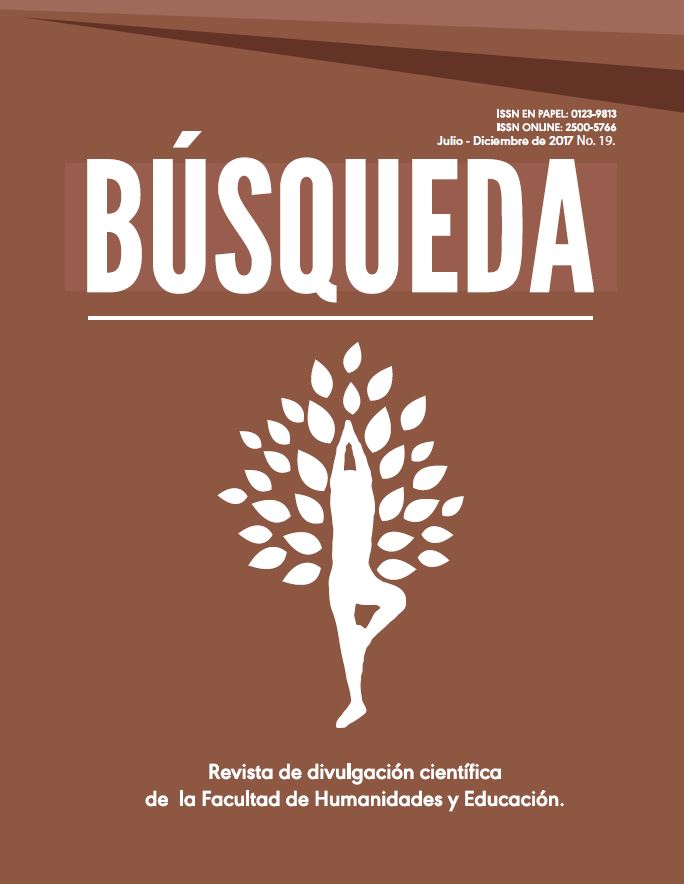
Abstract
The soccer referee has an important role during a game, for which you must have an adequate physical aptitude that allows an optimal physical performance in the arbitration. For that reason, the objective of this study, was to determine the maximum consumption of oxygen (Vo2max), maximum heart rate (MHR) and maximum aerobic speed (MAS) of Colombian soccer referees (CSF) at 320 meters on the level of the sea (320mls). An investigation of quantitative approach with a design of field and a sample of convenience voluntarily participating twelve referees, between 20 and 33 years old, voluntarily participated. They had distributed in groups of four by category: A, B and C. The Yo-Yo Test of resistance level 1 was applied to them, after signing an informed consent which specified the purpose of the study, the description of the test and its risks and benefits. The test was applied in the city of Cucuta, located at 320mls. The data were analyzed in the statistical package IBM SPSS V. 22, with a 95% confidence level and a p-value of 0.05, in which was a non-parametric statistic, and the Mann-Whitney U test was used. These are the results obtained by categories: a) Category A: Vo2max 81.33±3.35 ml.kg.min; MHR 196.50±2.65 ppm; MAS 5.11±0.11 m/s. b) Category B: Vo2max 75.23±1.73 ml.kg.min; MHR 194.75±2.06 ppm; MAS 4.79±0.08 m/s. c) Category C: Vo2max 70.97±1.95 ml.kg.min; MHR 189.50±3.11 ppm; MAS 4.65±0.08 m/s. The results showed statistically significant differences when comparing these variables (p<0.05). In conclusion, there are statistically significant differences between the Vo2max, MHR and MAS to CFS at 320mls (p<0.05).
Licence
References
Arecheta Pérez, C., Gómez López, M. y Lucía Mulas, A. (2006). La importancia del vo2max para realizar esfuerzos intermitentes de alta intensidad en el fútbol femenino de élite. Kronos, 5(9), 4-12. Recuperado de: https://dialnet.unirioja.es/servlet/articulo?codigo=2042032https://dialnet.unirioja.es/servlet/articulo?codigo=2042032
Arias, F. (2012). El Proyecto de investigación. Introducción a la metodología científica. Caracas, Venezuela: EDITORIAL EPISTEME, C. A.
Asociación Médica Mundial. (2013). Declaración de Helsinki de la AMM-Principios éticos para las investigaciones médicas en seres humanos. Recuperado de: http://www.isciii.es/ISCIII/es/contenidos/fd-investigacion/fd-evaluacion/fd-evaluacion-etica-investigacion/Declaracion-Helsinki-2013-Esp.pdfhttp://www.isciii.es/ISCIII/es/contenidos/fd-investigacion/fd-evaluacion/fd-evaluacion-etica-investigacion/Declaracion-Helsinki-2013-Esp.pdf
Bangsbo, J., Iaia, F. M. y Krustrup, P. (2008). The Yo-Yo intermittent recovery test. Sports medicine, 38(1), 37-51.
Billat, V., Bernard, O., Pinoteau, J., Petit, B., y Koralstein, J.P. (1994). Time to exhaustion at VO2 Máx and lactate steady velocity in subelite longdistance runner. Archives international oh Physiology. Biochemistry and Biophysique, 102(4) 215219. doi:. http://dx.doi.org/10.3109/13813459409007541
Campillo, P., Nkuignia, O. y Matías, C. (2013). Pruebas de velocidad aeróbica máxima con jóvenes futbolfutbolistas. Control y programación de la intensidad de los entrenamientos. Apunts. Educación Física y Deportes, 113, 45-51. Doi: http://dx.doi.org/10.5672/apunts.2014-0983.es.(2013/3).113.04http://dx.doi.org/10.5672/apunts.2014-0983.es.(2013/3).113.04
Casajus, J. A., y Castagna, C. (2007). Aerobic fitness and field test performance in elite Spanish soccer referees of different ages. Journal of Science &y Medicine in Sport, 10(6), 382–389. Doi: http://dx.doi.org/10.1016/j.jsams.2006.08.004
Castagna, C., Grant, y D’Ottavio, S. (2007). Physiological aspects of soccer refereeing performance and training. Sports Medicine, 37(7), 625-646. Recuperado de: https://www.researchgate.net/publication/256613906_Physiological_Aspects_of_Soccer_Refereeing_Performance_and_Traininghttps://www.researchgate.net/publication/256613906_Physiological_Aspects_of_Soccer_Refereeing_Performance_and_Training
Díaz, D. A. (2015). Tiempo límite a la velocidad asociada al consumo máximo de oxígeno en jóvenes atletas del municipio de Chía, Colombia. Lecturas: Educación Física y Deportes, 20(206). Recuperado de: http://www.efdeportes.com/efd206/velocidad-asociada-al-consumo-maximo-de-oxigeno.htmhttp://www.efdeportes.com/efd206/velocidad-asociada-al-consumo-maximo-de-oxigeno.htm
Fernández Vargas, G. E., Dda Silva, A. I., y Arruda, M. (2008). Perfil aAntropométrico y aAptitud fFísica de áÁrbitros del fFútbol pProfesional cChileno. International Journal of Morphology, 26(4), 897-904. Doi: http://dx.doi.org/10.4067/S0717-95022008000400019.
Gamboa Carmona, W. O., Forero Delgado, M. A., Urbina Bonilla, A. P. y Mendoza Romero, D. (2008). Comparación de dos pruebas de resistencia aeróbica continua e intermitente en condiciones de altura intermedia en árbitros de fútbol. Revista Corporeizando, 1(2), 38-49.
Harriss, D., &y Atkinson, G. (2013). Ethical standards in sport and exercise science research: 2014 update. International Journal of Sports Medicine, 34(12), 1025-1028. Doi: http://dx.doi.org/10.1055/s-0033-1358756
Longo, A. F., Aquilino, G. D., Cardey, M. L. y Lentini, N. A. (2017). VO˙ 2 max assessment in athletes: aA thorough method comparison study between Yo-Yo test and direct measurement. Apunts Med Esport, 52(193), 17-22. Doi: http://dx.doi.org/10.1016/j.apunts.2016.07.001
Mazaheri, R., Halabchi, F., Barghi, T. S., y Mansournia, M. A. (2016). Cardiorespiratory Fitness and Body Composition of Soccer Referees; Do These Correlate with Proper Performance? Asian Journal of Sports Medicine, 7(1). Doi: https://dx.doi.org/10.5812%2Fasjsm.29577
Mercado Ruíz, H. A., Sánchez Rodríguez, D. A. y Gutiérrez, J. (2015). Comportamiento de los niveles del vo2 máximo en futbolistas prejuveniles en diferentes altitudes. Revista digital: Actividad Física y Deporte, 1(2), 5-21. Recuperado de: http://www.udca.edu.co/wp-content/uploads/revista-deportes/revista-digital-actividad-fisica-deporte-vol1-no2.pdfhttp://www.udca.edu.co/wp-content/uploads/revista-deportes/revista-digital-actividad-fisica-deporte-vol1-no2.pdf
Moreno Suárez, E. L. (2001). Preparación del deportista para el entrenamiento de altura. Lecturas: Educación Física y Deporte, 7(40). Recuperado de: http://www.efdeportes.com/efd40/altura.htmhttp://www.efdeportes.com/efd40/altura.htm
Pallarés, J. G. y Morán-Navarro, R. (2012). Propuesta metodológica para el entrenamiento de la resistencia cardiorrespiratoria. Journal of Sport and Health Research, 4(2), 119-136. Recuperado de: http://journalshr.com/papers/Vol%204_N%202/V04_2_3.pdf
Reilly, T., Bangsbo, J., & Franks, A. (2000). Anthropometric and physiological predispositions for elite soccer. Journal of Sports Science, 18, 669-683.
Ruiz Caballero, J. A., Ojeda, E. B., Sarmiento, S., Valdivielso, M. N., García-Manso, J. M., Garcia-Aranda, J. M., Mallo, J., y Helsen, W. (2011). International SportMed Journal, 12(2), 85-91. Recuperado de: http://hdl.handle.net/10520/EJC48409
Scribano, A. (2007). El proceso de investigación social cualitativo. Buenos Aires, Argentina: Prometeo Libros.
Weston, M., Castagna, C., Impellizzeri, F. M., Bizzini, M., Williams, A. M., y Gregson, W. (2012). Science and Medicine Applied to Soccer Refereeing. Sport Medicine, 42(79), 615-–631. doi: https://doi.org/10.2165/11632360-000000000-00000
Whyte, G. P., George, K., Shave, R., Middleton, N., y Nevill, A. M. (2008). Training induced changes in maximum heart rate. International Journal of Sports Medicine, 29, 129-33.
Yanci Irigoyen, J., Reina Vaíllo, R., Granados Domínguez, C., Salinero Martín, J. J. y Los Arcos Larumbe, A. (2014). Valoración y relación de las características antropométricas y la condición física en árbitros de fútbol. Revista Española de Educación Física y Deportes, 406, 15-27. Recuperado de: http://reefd.es/index.php/reefd/article/view/23http://reefd.es/index.php/reefd/article/view/23
Zavorsky, G. S. (2000). Evidence and possible mechanisms of altered maximum heart rate with endurance training and tapering. Sports Medicine, 29, 13-26.

 PDF (Español (España))
PDF (Español (España))



